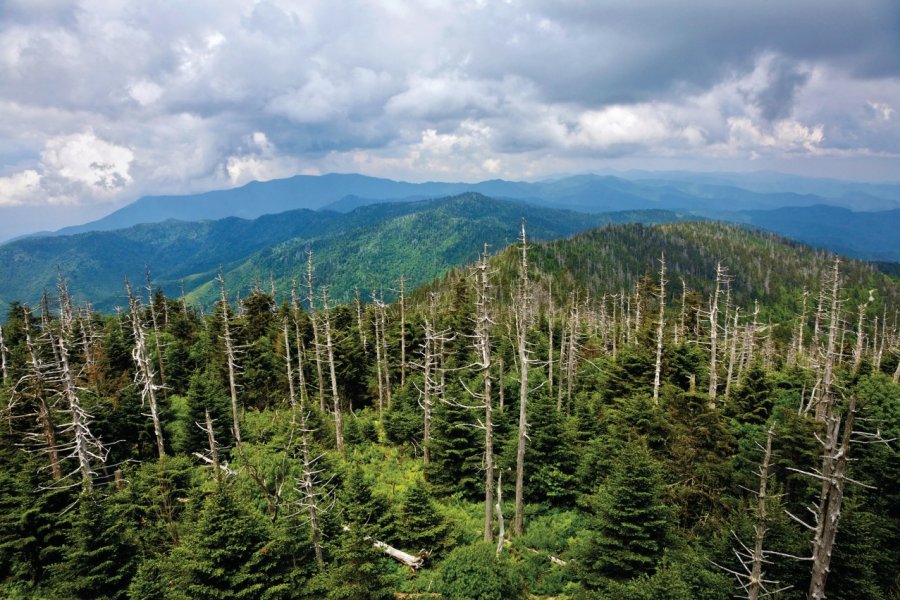Travel Guide Great Smoky Mountains National Park (Nc)
Find an accommodation
Advertising
North Carolina and Tennessee share the Great Smoky Mountains National Park, which is, with 10 million entries per year, the most visited park in the United States. It is also the main national park of the Appalachians, with that of Shenandoah in Virginia, both crossed by the Appalachian Trail. It covers a surface area of 2 110 km ² on an area of low, medium and high mountain whose highest point is the Clingmans Dome (2 025 m altitude).GeologyThe oldest rocks date from 545 to 800 million years. The erection between 310 and 245 million years of a very high mountain chain following the collision of two tectonic plates was the origin of the massive rejection of metamorphic rocks, such as sandstone, shales, quartzite and slate, which are the main rocks of the park. Similarly, at the margins of these two plates, eruptions of volcanoes occurred, rejecting on the surface of the eruptive rocks. The erosion caused by ice, wind and water has, over the millennia, cleared the most resistant layers to form the highest peaks of the Great Smoky Mountains, such as the hard metasandstone at the top of the Clingmans Dome.HistoryUntil the th century, when the earliest pioneers settled in the southeastern United States, the lands were occupied by several Indian tribes, including Cherokee. In 1830, President Andrew Jackson signed the Indian Removal Act. This irrevocable act orders the expulsion of all tribes located east of Mississippi to the current State of Oklahoma. The majority of Cherokee take the path to the exodus in 1838 (Trail of Tears) but some, guided by the Traditionalist Tsali, breed in the Great Smoky Mountains. Some of their descendants still live on the Réserve (Qualla Boundary) reserve located south of the park, the capital of which is Cherokee.After the installation of Europeans, the wood industry grew, so that at the end of the th century a train line was built, the Little River Railroad, for the transport of wood from remote areas. Very quickly, deforestation becomes a problem for local populations and visitors who demand protection from the area.Since the federal state does not have enough land, the creation of the park, although authorized by Congress in 1926, takes time to come. Billionaire John Rockefeller Junior made a donation of $ 5 million, to which two other millions of the U.S. government will add, without forgetting the participation of the citizens of Tennessee and North Carolina to form the park's land, parcel by parcel. It was only on June 15, 1934 that the park was officially created, and on September 2, 1940, it was inaugurated by President Franklin Delano Roosevelt. Declared Biosphere Reserve in 1976, the Great Smoky Mountains Park was also inscribed on the UNESCO World Heritage List in 1983.ClimateThe park enjoys a humid continental climate. The latter is so gentle that spring often declares itself in January. Annual rainfall is important and varies according to altitude. In the valleys it reaches 1 400 mm mm, but can range up to 2 200 mm at the highest points.NatureWith exceptional beauty, the park is home to at least 10 000 species of plants and animals. With 95 %, there are more than 100 species of trees. Low regions are dominated by deciduous forests, while upland areas are populated with conifers. Epicéas, fir and sorbiers cover the tops. There are also more than 5 400 plant species of which more than 1 400 species of flowers, including 30 varieties of orchids and ansérines. The park houses more than 200 species of birds, 66 mammal species, 50 fish, 43 amphibians, and 39 reptiles. The approximately 1 500 protected black bears that walk there should give you caution when hiking.
What to visit Great Smoky Mountains National Park (Nc)?
Suggested addresses Great Smoky Mountains National Park (Nc)
Weather at the moment
Advertising
Organize your trip with our partners Great Smoky Mountains National Park (Nc)
Transportation
Book your plane tickets
Car Rental
Boat rental
Accommodation & stays
Find a hotel
Holiday rental
Find your campsite
Tailor-made trip
Immersion travel
Services / On site
Activities & visits
Find a doctor







